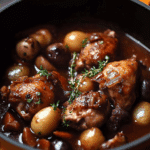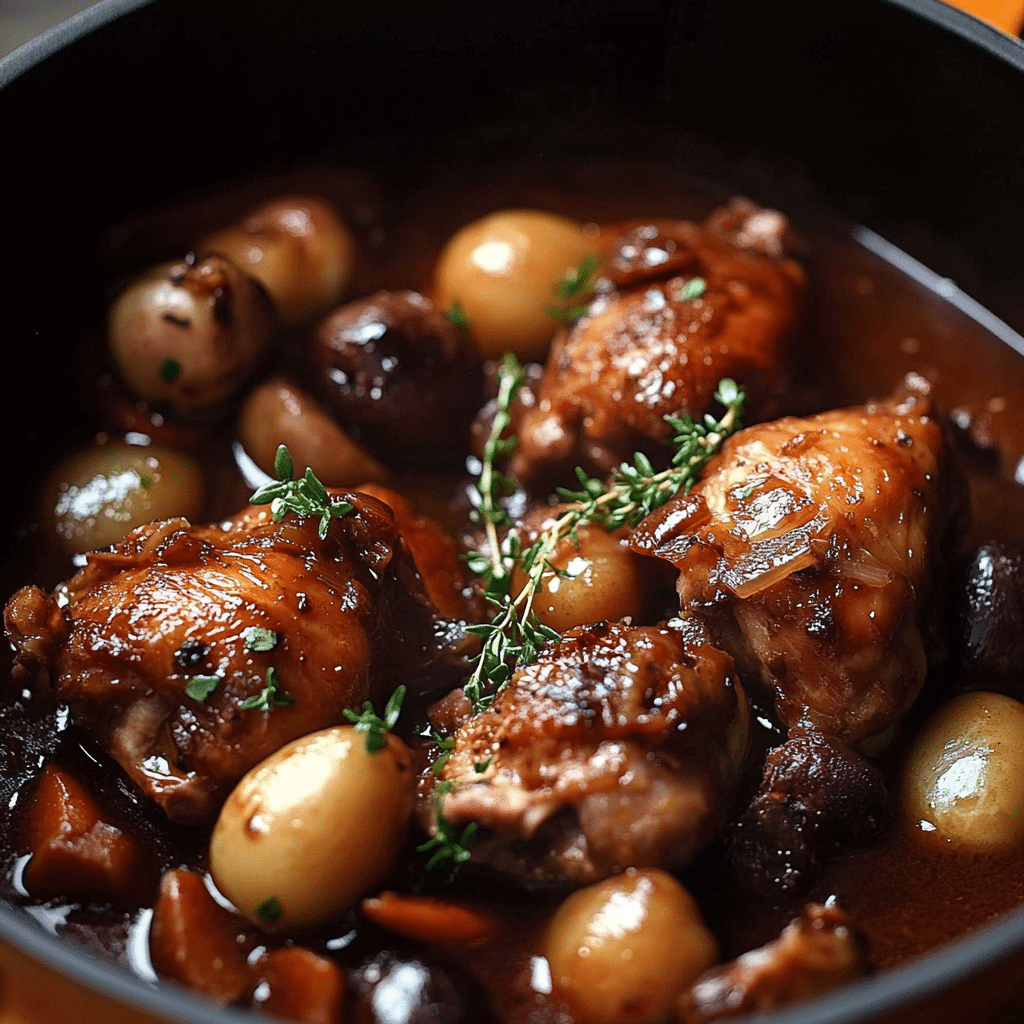Coq au Vin is a timeless French classic that brings together tender chicken, rich red wine, and an array of savory ingredients in a deeply flavorful stew. Learn how to make authentic Coq au Vin at home with our easy step-by-step recipe for rich, tender, and flavorful French classic that will impress your family and friends every time you serve it.
Why You’ll Love This Recipe
- Authentic flavors: Experience the deep, comforting taste of traditional French cooking in your own kitchen.
- Simple ingredients: Uses pantry staples and fresh produce, making it easy to prepare any day of the week.
- Versatile meal: Perfect for cozy dinners, special occasions, or meal prep with satisfying leftovers.
- Impressive presentation: Serves as a stunning centerpiece that will wow guests without complicated techniques.
- Comforting and hearty: A warm, satisfying dish ideal for cooler evenings or when you crave a rich stew.
Ingredients You’ll Need
Gathering the right ingredients is key to nailing the perfect Coq au Vin. Each element adds dimension—from tender textures to balanced acidity, and savory depth to the inviting color of the dish.
- Chicken thighs and drumsticks: Dark meat provides maximum flavor and stays juicy throughout slow cooking.
- Red wine: The backbone of the recipe, it infuses the chicken with vibrant depth and complexity.
- Bacon or pancetta: Adds smoky richness and a slight crisp texture when sautéed.
- Mushrooms: Earthy and tender, mushrooms soak up the wine sauce beautifully.
- Carrots and pearl onions: These vegetables add natural sweetness and color contrast.
- Garlic and fresh herbs: Essential aromatics like thyme, bay leaves, and parsley bring freshness and layers.
- Chicken stock: Balances the wine with savory warmth and boosts the sauce’s body.
- Flour: Helps to thicken the sauce and create a velvety texture.
- Butter and olive oil: Used for browning and building flavor bases.
- Salt and pepper: To season and enhance every ingredient’s natural taste.
Variations for Coq au Vin
One of the joys of Coq au Vin is how adaptable it is. Whether you want a lighter version or to mix up flavors, it’s simple to customize this beloved recipe.
- White wine version: Substitute red wine with dry white wine for a brighter, lighter flavor.
- Mushroom medley: Use a mix of wild mushrooms like shiitake, cremini, or chanterelles for added complexity.
- Vegetarian twist: Swap chicken for hearty vegetables and tofu, and replace stock with vegetable broth.
- Spices variation: Add a pinch of smoked paprika, nutmeg, or a dash of cinnamon for subtle warmth.
- Gluten-free option: Use cornstarch or arrowroot powder instead of flour to thicken the sauce without gluten.
How to Make Coq au Vin
Step 1: Prepare the chicken
Start by seasoning the chicken pieces with salt and pepper. Lightly dust them in flour which helps create a beautifully caramelized crust when brown in the pan. This step locks in moisture and adds a lovely texture to the finished dish.
Step 2: Brown the chicken and bacon
Heat butter and olive oil in a large heavy-bottomed pot over medium heat. Add the bacon or pancetta first to render its fat and crisp it up. Then brown the chicken pieces on all sides until golden. This caramelization builds deep flavor foundations essential for Coq au Vin.
Step 3: Sauté vegetables and aromatics
Remove the chicken and bacon temporarily. In the same pot, add pearl onions, carrots, and mushrooms, gently sautéing until soft. Stir in minced garlic, fresh thyme, and bay leaves to release their fragrant oils and aromatic notes.
Step 4: Deglaze with wine and simmer
Pour in the red wine, scraping the bottom of the pot to lift all those tasty browned bits. Bring to a gentle simmer before returning the chicken and bacon to the pot. Add chicken stock to cover and simmer with the lid partially on for about 45 minutes, allowing flavors to meld and the meat to become tender.
Step 5: Finish and thicken the sauce
Remove chicken and vegetables once cooked. Increase heat to reduce the sauce slightly. If necessary, stir in a slurry of flour and water to thicken it to a luscious consistency. Finally, return the chicken and veggies to the pot to heat through before serving.
Pro Tips for Making Coq au Vin
- Use good quality wine: Since wine is the star, select a bottle you enjoy drinking for best results.
- Marinate overnight: For extra flavor, marinate chicken in wine and aromatics before cooking.
- Brown in batches: Avoid overcrowding the pan when browning chicken to ensure proper caramelization.
- Low and slow simmer: Patience is key to achieving tender meat and melding flavors perfectly.
- Peel pearl onions easily: Briefly blanch onions in boiling water to slip skins off effortlessly.
- Adjust seasoning gradually: Taste throughout cooking to balance salt, acidity, and richness.
How to Serve Coq au Vin
Garnishes
Fresh parsley finely chopped makes a bright, fresh garnish that complements the deep sauce, while crispy bacon pieces add extra texture. A few sprigs of thyme on top add an aromatic flourish.
Side Dishes
Coq au Vin pairs beautifully with buttery mashed potatoes, crusty French bread to soak up the sauce, or creamy polenta for a comforting companion. Roasted seasonal vegetables or a simple green salad provide balance and color.
Creative Ways to Present
Serve Coq au Vin in individual rustic ceramic bowls for an authentic French bistro feel or family-style on a large platter for casual sharing. Adding a sprinkle of toasted almonds or a drizzle of balsamic reduction can elevate the presentation.
Make Ahead and Storage
Storing Leftovers
Place cooled Coq au Vin in an airtight container and refrigerate for up to 3 days. The flavors intensify overnight, making leftovers even more delicious.
Freezing
Freeze cooled portions in freezer-safe containers for up to 3 months. Make sure to leave some headspace as the sauce will expand when frozen.
Reheating
Gently reheat on the stove over low heat, stirring occasionally to prevent sticking, or use a microwave in short bursts. Adding a splash of stock or wine helps refresh the sauce’s consistency.
FAQs
Can I use chicken breasts instead of thighs?
While chicken breasts are leaner, dark meat like thighs and drumsticks work best for Coq au Vin as they stay moist and tender during the slow cooking process.
Which type of red wine should I use?
Choose a dry red wine with moderate tannins such as Pinot Noir, Burgundy, or Beaujolais for authentic flavor. Avoid overly harsh or sweet wines.
Can I make Coq au Vin in a slow cooker?
Absolutely! Brown the chicken first, then transfer all ingredients to a slow cooker and cook on low for 6 to 8 hours for tender results.
Is Coq au Vin gluten-free?
Traditionally it uses flour to thicken the sauce, but gluten-free flour or cornstarch can be substituted to make it gluten-free.
How do I peel pearl onions quickly?
Blanch the onions in boiling water for 1-2 minutes, drain, and immediately transfer to ice water; the skins will slip off easily.
Final Thoughts
Coq au Vin is truly one of those heartwarming dishes that brings joy to both the cook and anyone lucky enough to enjoy it. With its tender chicken, rich wine sauce, and rustic charm, this recipe invites you to slow down and savor every bite. Give it a try and watch it become a beloved staple in your kitchen, perfect for sharing with friends and family whether for a special occasion or a cozy night in.
Related Posts
- Why Creamy Orecchiette Pasta with Sausage Satisfies Cravings
- Quick Linguine with Clam Sauce: Easy & Delicious
- Quick Cilantro Pesto Chicken Tenders Delight

Coq au Vin
- Total Time: 1 hour 20 minutes
- Yield: 4 servings 1x
- Diet: Gluten Free
Description
Coq au Vin is a classic French stew featuring tender chicken cooked slowly in rich red wine with bacon, mushrooms, pearl onions, and fresh herbs. This comforting and hearty dish offers deep authentic flavors perfect for cozy dinners and special occasions, with simple ingredients and an impressive presentation.
Ingredients
Protein
- 6 chicken thighs and drumsticks (dark meat preferred)
- 4 oz bacon or pancetta, diced
Vegetables and Aromatics
- 1 cup pearl onions (peeled)
- 2 medium carrots, sliced
- 8 oz mushrooms, cleaned and sliced
- 3 cloves garlic, minced
- 2 sprigs fresh thyme
- 2 bay leaves
- 2 tbsp fresh parsley, chopped (for garnish)
Liquids and Broth
- 2 cups dry red wine (e.g., Pinot Noir, Burgundy, or Beaujolais)
- 2 cups chicken stock
Pantry Staples and Others
- 2 tbsp all-purpose flour (or gluten-free alternative like cornstarch)
- 2 tbsp butter
- 2 tbsp olive oil
- Salt and freshly ground black pepper, to taste
Instructions
- Prepare the chicken: Season chicken pieces with salt and pepper. Lightly dust each piece with flour to help create a caramelized crust during browning. This step locks in moisture and adds texture.
- Brown the chicken and bacon: Heat butter and olive oil in a large heavy-bottomed pot over medium heat. Add diced bacon or pancetta first and cook until rendered and crisp. Then add the chicken pieces and brown on all sides until golden, building deep foundational flavors.
- Sauté vegetables and aromatics: Remove chicken and bacon from the pot and set aside. In the same pot, add pearl onions, sliced carrots, and mushrooms. Sauté gently until softened. Stir in minced garlic, fresh thyme sprigs, and bay leaves to release aromatic oils.
- Deglaze with wine and simmer: Pour in the red wine, scraping the bottom of the pot to lift browned bits. Bring to a gentle simmer. Return the browned chicken and bacon to the pot, then add chicken stock to cover. Partially cover with a lid and simmer for about 45 minutes until the chicken is tender and flavors are well blended.
- Finish and thicken the sauce: Remove the chicken and vegetables once cooked. Increase heat to reduce the sauce slightly. If needed, stir in a slurry made from flour and water (or gluten-free substitute) to thicken to a luscious consistency. Return chicken and veggies to the pot and heat through before serving.
Notes
- Use good quality dry red wine that you enjoy drinking for the best flavor.
- For extra depth, marinate the chicken overnight in wine and aromatics.
- Brown chicken in batches to avoid overcrowding and ensure proper caramelization.
- Simmer low and slow to get tender meat and well-developed flavors.
- To peel pearl onions easily, blanch them briefly in boiling water, then transfer to ice water—the skins will slip off.
- Taste and adjust seasoning throughout cooking to balance saltiness and acidity.
- Prep Time: 20 minutes
- Cook Time: 1 hour
- Category: Main Course
- Method: Braising
- Cuisine: French
Nutrition
- Serving Size: 1 serving
- Calories: 450 kcal
- Sugar: 5 g
- Sodium: 750 mg
- Fat: 25 g
- Saturated Fat: 9 g
- Unsaturated Fat: 13 g
- Trans Fat: 0 g
- Carbohydrates: 12 g
- Fiber: 2 g
- Protein: 35 g
- Cholesterol: 130 mg


